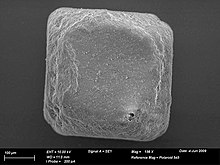Health effects of salt
[4][5] The WHO further recommends that salt intake be adjusted for those aged 2 to 15 years old based on their energy requirements relative to those of adults.
However, some studies have found that sodium intake that is below 3 g per day (equivalent to about 7.5 g of salt) may increase the risk for cardiovascular disease and early death.
[14] Hyponatremia, or blood sodium levels below 135 mEq/L, causes brain cells to swell; the symptoms can be subtle and may include altered personality, lethargy, and confusion.
In severe cases, when blood sodium falls below 115 mEq/L, stupor, muscle twitching or spasms, seizures, coma, and death can result.
[15] Major health organizations and recent reviews state that high consumption of salt increases the risk of several diseases in children and adults.
[19] Normotensive overweight/obese patients who were salt restricted for six weeks showed an endothelin 1 (ET-1) decrease of 14% associated with a 45% increase in flow-mediated dilation (FMD).
[21] Another study using middle-aged or older adults with moderately elevated blood pressure taking sodium chloride tablets or placebo tablets for a few weeks showed that sodium restriction increased nitric oxide and tetrahydrobiopterin (BH4) resulting in improved FMD without affecting blood pressure.
This ranged across many cultures, and together with animal studies, this suggests that sodium intake is tightly controlled by feedback loops in the body.
[50] Upon review, an expert committee that was commissioned by the Institute of Medicine and the Centers for Disease Control and Prevention reported that there was no health outcome-based rationale for reducing daily sodium intake levels below 2,300 milligrams, as had been recommended by previous dietary guidelines; the report did not have a recommendation for an upper limit of daily sodium intake.
In the UK, foods produced by some supermarkets and manufacturers have 'traffic light' colors on the front of the packet: red (high), amber (medium), or green (low).
The 2008 focus includes raising awareness of high levels of salt hidden in sweet foods that are marketed towards children.
[67] From around 2010 to 2022, as part of the Sodium Reduction in Communities Program (SRCP), the United States Centers for Disease Control and Prevention funded local communities across the United States to implement a variety of policy, systems, and environmental change strategies focused on increasing access to lower sodium foods in a variety of settings such as hospitals, congregate meal sites, and university settings.
The use of a salt substitute can provide a taste offsetting the perceived blandness of low-salt food; potassium chloride is widely used for this purpose.
[74] Studies found that excessively low sodium intake, below about three grams (3,000 mg) of salt per day, is associated with increased mortality and higher risk for cardiovascular disease.
This review also indicates potential negative side effects on hormones and lipid levels, so that decreasing salt intake is not necessarily recommended for people with normal blood pressure.
In people with chronic kidney disease, including those on dialysis, there is high-certainty evidence that dietary salt restriction may help to lower systolic and diastolic blood pressure, as well as albuminuria.
The effect of salt restriction on extracellular fluid, oedema, and total body weight reduction is also uncertain.
